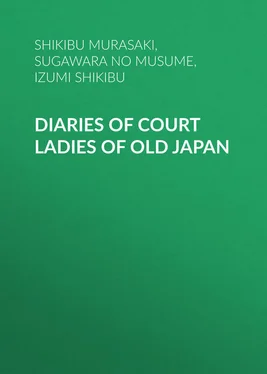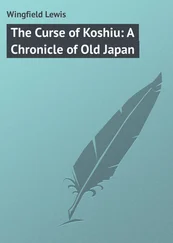Shikibu Murasaki - Diaries of Court Ladies of Old Japan
Здесь есть возможность читать онлайн «Shikibu Murasaki - Diaries of Court Ladies of Old Japan» — ознакомительный отрывок электронной книги совершенно бесплатно, а после прочтения отрывка купить полную версию. В некоторых случаях можно слушать аудио, скачать через торрент в формате fb2 и присутствует краткое содержание. Жанр: История, foreign_edu, на английском языке. Описание произведения, (предисловие) а так же отзывы посетителей доступны на портале библиотеки ЛибКат.
- Название:Diaries of Court Ladies of Old Japan
- Автор:
- Жанр:
- Год:неизвестен
- ISBN:нет данных
- Рейтинг книги:4 / 5. Голосов: 1
-
Избранное:Добавить в избранное
- Отзывы:
-
Ваша оценка:
- 80
- 1
- 2
- 3
- 4
- 5
Diaries of Court Ladies of Old Japan: краткое содержание, описание и аннотация
Предлагаем к чтению аннотацию, описание, краткое содержание или предисловие (зависит от того, что написал сам автор книги «Diaries of Court Ladies of Old Japan»). Если вы не нашли необходимую информацию о книге — напишите в комментариях, мы постараемся отыскать её.
Diaries of Court Ladies of Old Japan — читать онлайн ознакомительный отрывок
Ниже представлен текст книги, разбитый по страницам. Система сохранения места последней прочитанной страницы, позволяет с удобством читать онлайн бесплатно книгу «Diaries of Court Ladies of Old Japan», без необходимости каждый раз заново искать на чём Вы остановились. Поставьте закладку, и сможете в любой момент перейти на страницу, на которой закончили чтение.
Интервал:
Закладка:
Various
Diaries of Court Ladies of Old Japan The Sarashina Diary, The Diary of Murasaki Shikibu, The Diary of Izumi Shikibu
TRANSLATORS' NOTE
The poems in the text, slight and occasional as they are, depending often for their charm on plays upon words of two meanings, or on the suggestions conveyed to the Japanese mind by a single word, have presented problems of great difficulty to the translators, not perfectly overcome.
Izumi Shikibu's Diary is written with extreme delicacy of treatment. English words and thought seem too downright a medium into which to render these evanescent, half-expressed sentences and poems – vague as the misty mountain scenery of her country, with no pronouns at all, and without verb inflections. The shy reserve of the lady's written record has induced the use of the third person as the best means of suggesting it.
Of the "Sarashina Diary" there exist a few manuscript copies, and three or four publications of the text. Some of them are confused and unreadably incoherent. The present translation was done by comparing all the texts accessible, and is especially founded on the connected text by Mr. Sakine, professor of the Girls' Higher Normal School, Tokio, published by Meiji Shoin, Itchome Nishiki-cho, Kanda-ku, Tokio. As far as possible the exact meaning has been adhered to, and the words chosen to express it have been kept absolutely simple, without complexity of thought, for such is the vocabulary in which it was written. Sometimes the diarist uses the present tense, sometimes the text seems reminiscent. The words in square brackets have been inserted by the translators to complete the sense in English of sentences which literally rendered do not carry with them the suggestion of the Japanese text.
INTRODUCTION
The Japanese have a convenient method of calling their historical periods by the names of the places which were the seats of government while they lasted. The first of these epochs of real importance is the Nara Period, which began A.D. 710 and endured until 794; all before that may be classed as archaic. Previous to the Nara Period, the Japanese had been a semi-nomadic race. As each successive Mikado came to the throne, he built himself a new palace, and founded a new capital; there had been more than sixty capitals before the Nara Period. Such shifting was not conducive to the development of literature and the arts, and it was not until a permanent government was established at Nara that these began to flourish. This is scarcely the place to trace the history of Japanese literature, but fully to understand these charming "Diaries of Court Ladies of Old Japan," it is necessary to know a little of the world they lived in, to be able to feel their atmosphere and recognize their allusions.
We know a good deal about Japan to-day, but the Japan with which we are familiar only slightly resembles that of the Diaries. Centuries of feudalism, of "Dark Ages," have come between. We must go behind all this and begin again. We have all heard of the "Forty-seven Ronins" and the Nō Drama, of Shōguns, Daimios, and Samurais, and many of us live in daily communion with Japanese prints. It gives us pause to reflect that the earliest of these things is almost as many centuries ahead of the Ladies as it is behind us. "Shōgun" means simply "General," and of course there were always generals, but the power of the Shōguns, and the military feudalism of which the Daimios and their attendant Samurais were a part, did not really begin until the middle of the twelfth century and did not reach its full development until the middle of the fourteenth; the Nō Drama started with the ancient religious pantomimic dance, the Kagura, but not until words were added in the fourteenth century did it become the Nō; and block colour printing was first practised in 1695, while such famous print artists as Utamaro, Hokusai, and Hiroshige are all products of the eighteenth or early nineteenth centuries. To find the Ladies behind the dark military ages, we must go back a long way, even to the century before their own, and so gain a sort of perspective for them and their time.
Chinese literature and civilization were introduced into Japan somewhere between 270 and 310 A.D., and Buddhism followed in 552. Of course, all such dates must be taken with a certain degree of latitude; Oriental historians are anything but precise in these matters. Chinese influence and Buddhism are the two enormous facts to be reckoned with in understanding Japan, and considering what an effect they have had, it is not a little singular that Japan has always been able to preserve her native character. To be sure, Shintoism was never displaced by Buddhism, but the latter made a tremendous appeal to the Japanese temperament, as the Diaries show. In fact, it was not until the Meiji Period (1867-1912) that Shintoism was again made the state religion. With the introduction of Chinese civilization came the art of writing, when is not accurately known, but printing from movable blocks followed from Korea in the eighth century. As was inevitable under the circumstances, Chinese came to be considered the language of learning. Japanese scholars wrote in Chinese. All the "serious" books – history, theology, science, law – were written in Chinese as a matter of course. But, in 712, a volume called "Records of Ancient Matters" was compiled in the native tongue. It is the earliest book in Japanese now extant.
If the scholars wrote in a borrowed language, the poets knew better. They wrote in their own, and the poetry of the Nara Period has been preserved for us in an anthology, the "Manyoshu" or "Collection of One Thousand Leaves." This was followed at the beginning of the tenth century by the "Kokinshu" ("Ancient and Modern Poems"), to which, however, the editor, Tsurayuki, felt obliged to write a Chinese preface. The Ladies of the Diaries were extremely familiar with these volumes, their own writings are full of allusions to poems contained in them; Sei-Shōnagon, writing early in the eleventh century, describes a young lady's education as consisting of writing, music, and the twenty volumes of the "Kokinshu." So it came about that while learned gentlemen still continued to write in Chinese, poetry, fiction, diaries, and desultory essays called "Zui-hitsu" (Following the Pen) were written in Japanese.
Now the position of women at this time was very different from what it afterwards became in the feudal period. The Chinese called Japan the "Queen Country," because of the ascendancy which women enjoyed there. They were educated, they were allowed a share of inheritance, and they had their own houses. It is an extraordinary and important fact that much of the best literature of Japan has been written by women. Three of these most remarkable women are the authors of the Diaries; a fourth to be named with them, Sei-Shōnagon, to whom I have just referred, was a contemporary.
In 794, the capital was moved from Nara to Kiōto, which was given the name of "Heian-jo" or "City of Peace," and with the removal, a new period, the Heian, began. It lasted until 1186, and our Ladies lived in the very middle of it.
By this time Japan was thoroughly civilized; she was, indeed, a little over-civilized, a little too fined down and delicate. At least this is true of all that life which centred round the court at Kiōto. To historians the Heian Period represents the rise and fall of the Fujiwara family. This powerful family had served the Mikados from time out of mind as heads of the Shinto priests, and after the middle of the seventh century, they became ministers or prime ministers. An immense clan, they gradually absorbed all the civil offices in the Kingdom, while the military offices were filled by the Taira and Minamoto families.
Читать дальшеИнтервал:
Закладка:
Похожие книги на «Diaries of Court Ladies of Old Japan»
Представляем Вашему вниманию похожие книги на «Diaries of Court Ladies of Old Japan» списком для выбора. Мы отобрали схожую по названию и смыслу литературу в надежде предоставить читателям больше вариантов отыскать новые, интересные, ещё непрочитанные произведения.
Обсуждение, отзывы о книге «Diaries of Court Ladies of Old Japan» и просто собственные мнения читателей. Оставьте ваши комментарии, напишите, что Вы думаете о произведении, его смысле или главных героях. Укажите что конкретно понравилось, а что нет, и почему Вы так считаете.












